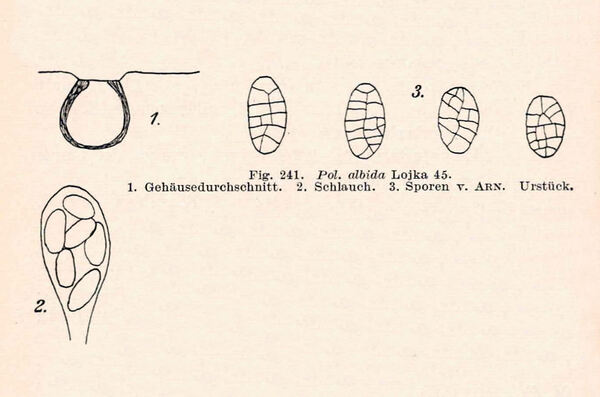Polyblastia albida Arnold
Flora, 41: 551, 1858.
Synonyms: Polyblastia alpina Metzler; Polyblastia circularis Blomb. ex T. Fr.; Polyblastia rodnensis Zschacke; Verrucaria lariana var. albida (Arnold) Garov.
Distribution: N - Frl, Ven, TAA (Nascimbene & al. 2007b, 2022), Piem (Isocrono & al. 2004). C - Marc (Nimis & Tretiach 1999), Umb (Genovesi & Ravera 2001, Ravera & al. 2006), Abr (Cucchi & al. 2009, Gheza & al. 2021). S - Camp (Garofalo & al. 1999, 2010, Aprile & al. 2003b), Cal (Nimis & Puntillo 2003, Puntillo 2011).
Description: Thallus crustose, endosubstratic or thinly hemiendosubstratic, continuous, whitish to cream-coloured, smooth to rugose, often inapparent; deeper parts of thallus often with globose, up to 7 μm thick oil-cells. Perithecia numerous, black, globose, 0.2-0.35 mm across, completely immersed and leaving pits in the rock, visible as black dots corresponding to the sometimes slightly emerging, flattened periostiolar region. Involucrellum absent or poorly developed, apically 38–56 μm thick, adpressed to the exciple or diverging laterally, reaching halfway down, of intertwined, heavily sclerotized cells; exciple globose, dark throughout or sometimes paler in lower part, slightly thicker in the apical part; hamathecium of periphyses and periphysoids, interascal filaments absent; hymenial gel hemiamyloid, I+ red (I+ blue at very low concentrations of I), K/I+ blue. Asci 8-spored, clavate, K/I-, fissitunicate, the wall thickened above, with an ocular chamber, dehiscent by extrusion of an endotunica to form a delicate rostrum. Ascospores muriform, with 6-8 transverse septa and (2-)3-4 longitudinal septa, hyaline, ellipsoid, 22.5-29 x 11.3-14 μm. Photobiont chlorococcoid. Spot tests: K-, C-, KC-, P-, UV-. Chemistry: without lichen substances.Note: on hard calciferous rocks and dolomite in sheltered situations, also within forests; frequent in the Alps, much rarer in the Apennines, where it is confined to high altitudes.
Growth form: Crustose endolithic
Substrata: rocks
Photobiont: green algae other than Trentepohlia
Reproductive strategy: mainly sexual
Commonnes-rarity: (info)
Alpine belt: rare
Subalpine belt: rather rare
Oromediterranean belt: very rare
Montane belt: rather rare
Submediterranean belt: absent
Padanian area: absent
Humid submediterranean belt: absent
Humid mediterranean belt: absent
Dry mediterranean belt: absent

Predictive model
Herbarium samples
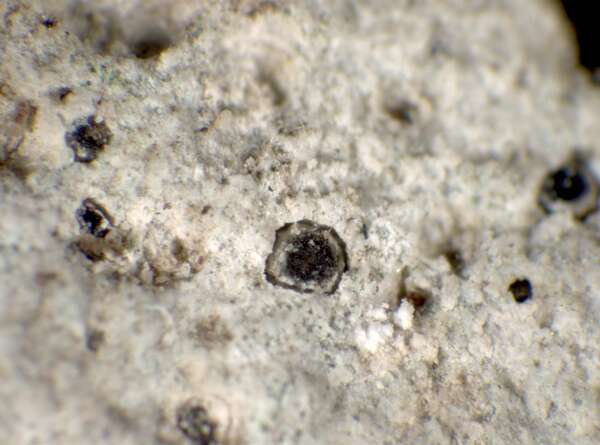

P.L. Nimis; Owner: Department of Life Sciences, University of Trieste
Herbarium: TSB (24224)
2001/12/12
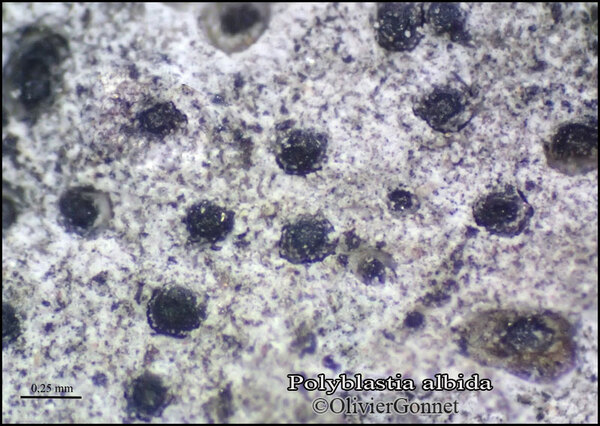
Courtesy Danièle et Olivier Gonnet - Source: https://www.afl-lichenologie.fr/Photos_AFL/Photos_AFL_P/Text_P_4/Polyblastia_albida.htm
France, 18/5/2015 - Salignac-Eyvigues - Dordogne
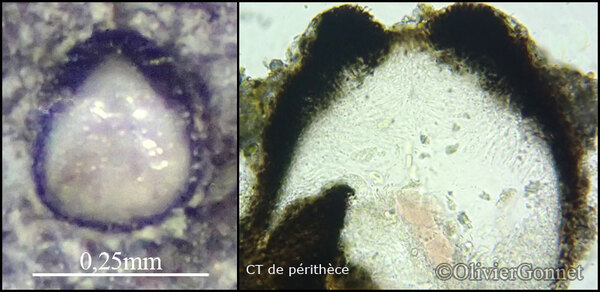
Courtesy Danièle et Olivier Gonnet - Source: https://www.afl-lichenologie.fr/Photos_AFL/Photos_AFL_P/Text_P_4/Polyblastia_albida.htm
France, 18/5/2015 - Salignac-Eyvigues - Dordogne

Courtesy Danièle et Olivier Gonnet - Source: https://www.afl-lichenologie.fr/Photos_AFL/Photos_AFL_P/Text_P_4/Polyblastia_albida.htm
France, 18/5/2015 - Salignac-Eyvigues - Dordogne
Growth form: Crustose endolithic
Substrata: rocks
Photobiont: green algae other than Trentepohlia
Reproductive strategy: mainly sexual
Commonnes-rarity: (info)
Alpine belt: rare
Subalpine belt: rather rare
Oromediterranean belt: very rare
Montane belt: rather rare
Submediterranean belt: absent
Padanian area: absent
Humid submediterranean belt: absent
Humid mediterranean belt: absent
Dry mediterranean belt: absent

Predictive model
| Herbarium samples |


P.L. Nimis; Owner: Department of Life Sciences, University of Trieste
Herbarium: TSB (24224)
2001/12/12

Courtesy Danièle et Olivier Gonnet - Source: https://www.afl-lichenologie.fr/Photos_AFL/Photos_AFL_P/Text_P_4/Polyblastia_albida.htm
France, 18/5/2015 - Salignac-Eyvigues - Dordogne

Courtesy Danièle et Olivier Gonnet - Source: https://www.afl-lichenologie.fr/Photos_AFL/Photos_AFL_P/Text_P_4/Polyblastia_albida.htm
France, 18/5/2015 - Salignac-Eyvigues - Dordogne

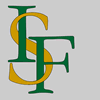 INDEX FUNGORUM
INDEX FUNGORUM
 GBIF
GBIF
 DOLICHENS
DOLICHENS
